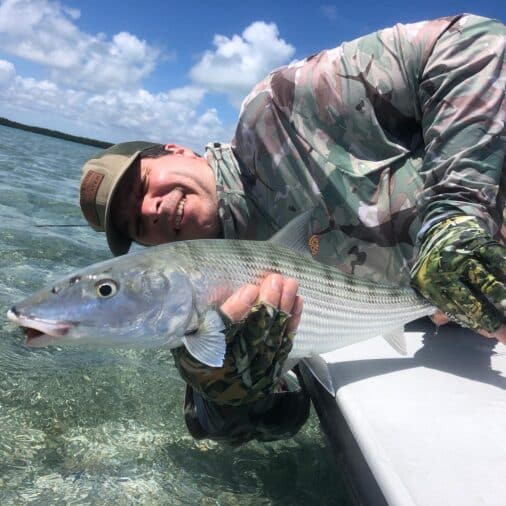Biscayne Bay, a shimmering oasis of turquoise waters and lush seagrass beds, is nestled between the bustling metropolis of Miami and the serene Florida Keys. This pristine estuary is home to an array of fascinating marine species, but one fish in particular has captivated the hearts and minds of anglers around the world: the bonefish.
Revered for its speed and elusiveness, the bonefish is the ultimate prize for fly fishers seeking a thrilling challenge.
In this article, we dive into the art of fly fishing for bonefish in Biscayne Bay, exploring the best tackle and equipment, interesting facts about this incredible fish, and the optimal times of year to cast your line.
The Tackle and Equipment
Fly fishing for bonefish in Biscayne Bay requires specialized tackle and equipment designed to handle the unique challenges of the sport. Here are the essentials you’ll need:

Flies: Bonefish in Biscayne Bay primarily feed on shrimp, crabs, and small baitfish. As such, your fly selection should include patterns that imitate these prey items. Popular choices include bonefish toads, small merkin crab, and Capt. Raul Montoro ST bonefish shrimp. Opt for flies in sizes 4 to 8 and colors that match the local forage and bottom conditions.
Five Interesting Facts About Bonefish
Best Time of Year to Fly Fish for Bonefish in Biscayne Bay
Although bonefish can be found in Biscayne Bay year-round, the best months to target them are typically December through June. Biscayne Bay, located on the southeastern coast of Florida, is one of the most popular destinations for bone fishing in the United States. Bonefish, also known as the grey ghost, are highly sought after by anglers due to their elusive nature and challenging behavior.
During the winter months, the water temperature in Biscayne Bay drops, causing the bonefish to move into slightly deeper waters where water temps are actually warmer. Bonefish can be easily spotted and targeted by anglers from two to four feet of water. Water temps will dictate the water depths they are more likely to be. Additionally, the cooler water temperatures make bonefish more active, resulting in increased feeding behavior and more aggressive strikes.
Overall, the best time to fly fish for bonefish in Biscayne Bay, Florida is during the winter months, between December through May. During this time, bonefish are more active, move into shallower waters, and can be easily spotted and targeted by anglers. However, bone fishing is still possible year-round in the area, and anglers should be prepared for different weather conditions depending on the time of year they choose to fish.
Interested in hiring a Miami flats fishing guide? Contact us for more details.